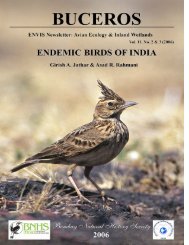Untitled - ENVIS Centre on Avian Ecology
Untitled - ENVIS Centre on Avian Ecology
Untitled - ENVIS Centre on Avian Ecology
You also want an ePaper? Increase the reach of your titles
YUMPU automatically turns print PDFs into web optimized ePapers that Google loves.
CRITICALLY ENDANGERED<br />
THREATENED BIRDS OF INDIA<br />
Buceros Vol. 7 & No. 1 & 2 (2002)<br />
the nineteenth century at four localities in two widely<br />
separated general areas in the west and east of the<br />
subc<strong>on</strong>tinent 1 . In 2000, a survey of 14 forest areas across<br />
its former range located 25 birds at four sites in northern<br />
Maharashtra and south-western Madhya Pradesh,<br />
including three pairs at Taloda Forest Range and seven<br />
pairs at Toranmal Forest Range 2 .<br />
Populati<strong>on</strong>: The past and present numerical status of the<br />
Forest Owlet is unknown. In November 1997, two birds<br />
were rediscovered following unsuccessful searches for<br />
the species at the other known localities 3,4,5,6,7,8 . Following<br />
field surveys in March 1999 and January–February 2000,<br />
three pairs were sighted at Taloda forest range, seven<br />
pairs at Toranmal forest range (Shahada), two pairs at<br />
Khaknar forest range and a single bird at Melghat<br />
Sanctuary, yielding a grand total of 25 birds 2 .<br />
Main threats: In 1998, it was discovered that forest loss<br />
was very severe at the site of the rediscovery of the<br />
species; there is intense pressure from local people <strong>on</strong><br />
the forest resources in the area 9 . An area of 50 sq. km<br />
was cleared in the vicinity of the November 1997<br />
rediscovery within six m<strong>on</strong>ths, to make way for people<br />
displaced by the Sardar Sarovar Dam 10,11 . All sites for<br />
the species are located in reserve forest and most feeding<br />
n n n<br />
18<br />
sites are in teak plantati<strong>on</strong>s; many trees are being cut in<br />
these plantati<strong>on</strong>s, and the cleared areas are being<br />
cultivated by tribal people, who have encroached up<strong>on</strong><br />
large chunks of forest land12 . There is a scarcity of trees<br />
with suitable nest holes in the areas studied10 . Livestock<br />
and fuelwood-gatherers appear to cause sufficient<br />
disturbance for the birds to leave the vicinity for the<br />
durati<strong>on</strong>9 . Tribals use various owl parts for magic and<br />
therefore hunt the owlet 13<br />
.<br />
C<strong>on</strong>servati<strong>on</strong> measures: The Forest Owlet is classed<br />
as a Schedule 1 species under India’s Wildlife Protecti<strong>on</strong><br />
Act (1972) 10 , and it is listed <strong>on</strong> Appendix I of<br />
CITES.<br />
References: 1. Rasmussen and Collar 1998; 2. Ishtiaq<br />
and Rahmani 2000; 3. King and Rasmussen 1998; 4.<br />
Gallagher 1998; 5. Rasmussen 1998a; 6. Rasmussen<br />
1998b; 7. Rasmussen 1998c; 8. Rasmussen 1998d; 9.<br />
Rasmussen and Ishtiaq 1999; 10. Ishtiaq 2000a; 11.<br />
Ishtiaq 2000b; 12. Ishtiaq 1999; 13. Jathar, G. 2002.<br />
Forest Owlet in the IBAs<br />
Maharashtra: 1.Taloda Reserve Forest; 2. Melghat Tiger<br />
Reserve, 3. Toranmal RF; Chattishgarh: 1. Barnawapara<br />
WLS; Madhya Pradesh: Khaknaar Forest Range.




